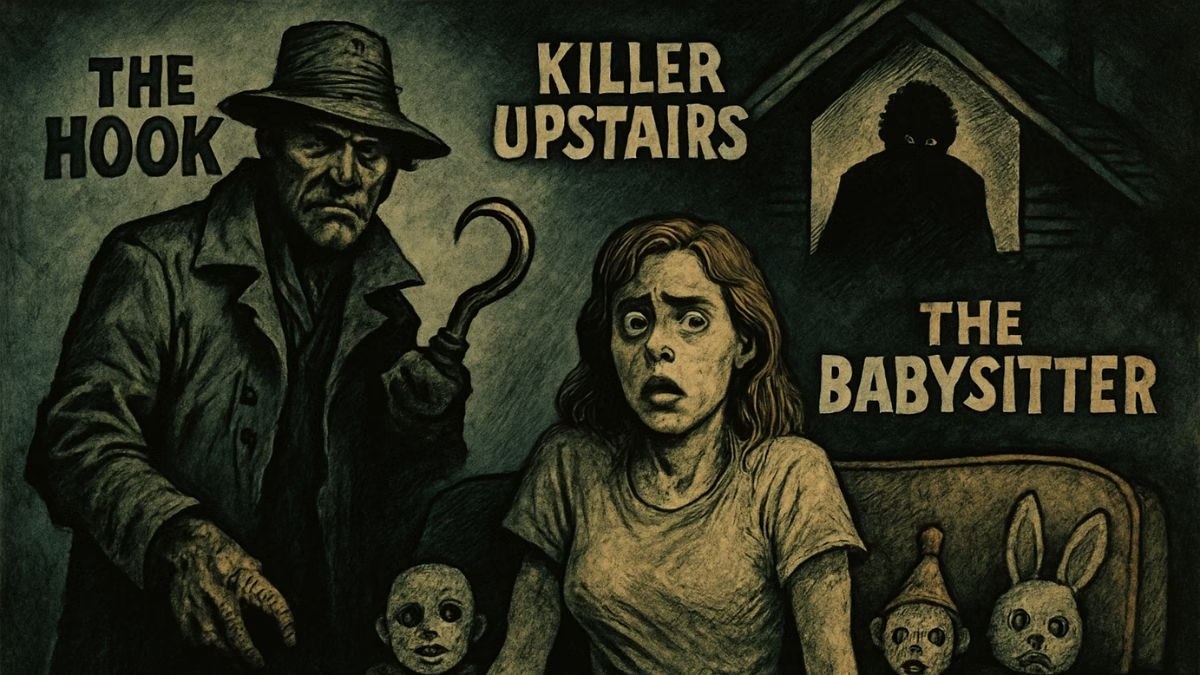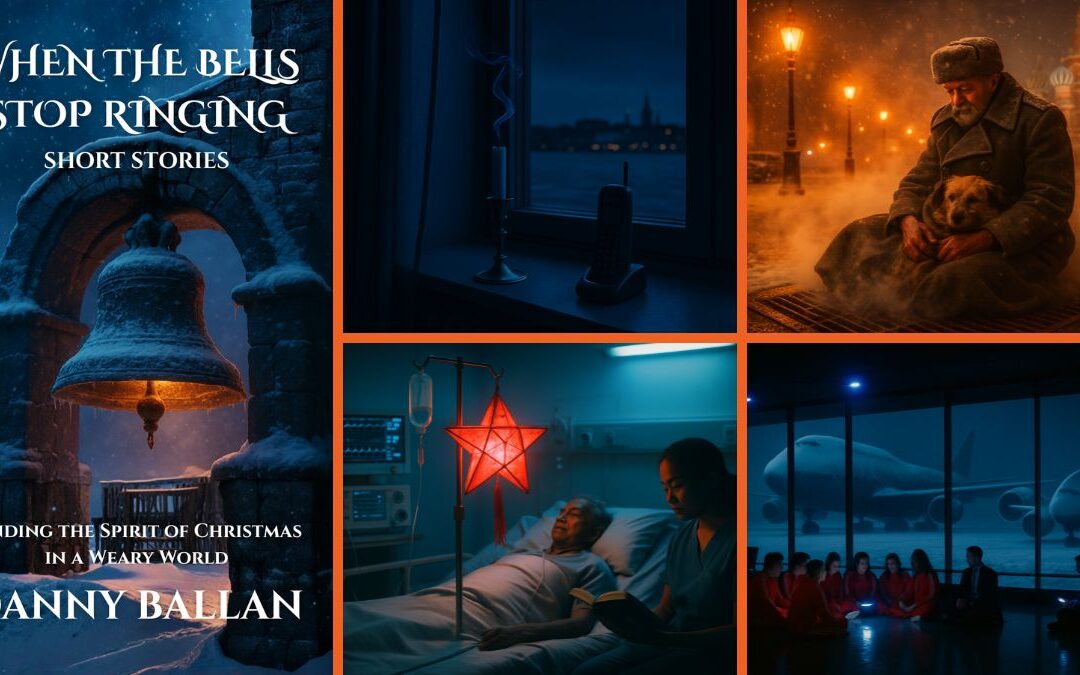- Audio Article
- The Ghost Stories We Tell at Night
- More Than Just a Ghost Story: What Are Urban Legends, Really?
- The Anatomy of a Warning: Deconstructing the Legends
- The Cultural Echo Chamber: Why These Tropes Persist
- Reclaiming the Narrative: Modern Legends and Feminist Retellings
- The Stories We Tell Ourselves
- MagTalk Discussion
- Focus on Language
- Vocabulary Quiz
- Let’s Discuss
- Learn with AI
- Let’s Play & Learn
Audio Article
The Ghost Stories We Tell at Night
Lean in closer to the metaphorical campfire. Remember the feeling? The sleeping bag pulled up to your chin, the flashlight beam trembling in your hand, the voice of a friend dropping to a conspiratorial whisper. It’s in these hushed, breathless moments that we first meet them: the young woman who hears a strange scratching sound on the roof of the car, the babysitter who gets a terrifying phone call, the college student who returns to her dorm room to find her roommate murdered.
These stories—”The Hook,” “The Babysitter and the Man Upstairs,” “The Roommate’s Death”—are pillars of American folklore. They are passed down through generations of sleepovers and campfire gatherings, evolving with each telling but always retaining their chilling core. We love them for the jolt of fear they provide, the delicious shiver that runs down our spines. But have you ever stopped to ask why the protagonist of these terrifying tales is almost always a young woman? Why is she so often alone, isolated, and punished for the slightest transgression?
These classic urban legends are far more than simple spooky stories. They are cultural artifacts, time capsules of the societies that created them. When we hold these tales up to the light and examine them through a modern feminist lens, they reveal a complex and often troubling undercurrent of societal anxieties about female independence, burgeoning sexuality, and the seismic shifts in women’s roles that defined the 20th century. These aren’t just ghost stories; they are warnings, morality plays disguised as entertainment, and their echoes still resonate today.
More Than Just a Ghost Story: What Are Urban Legends, Really?
Before we dissect our damsels in distress, it’s crucial to understand what we’re dealing with. Urban legends are the folklore of the modern world. Unlike ancient myths tied to gods and creation, these stories are set in our world of cars, telephones, and quiet suburban streets. They are almost always told as true, having happened to a “friend of a friend,” a clever narrative device that lends them an unnerving plausibility.
But their primary function isn’t just to scare us. At their core, urban legends are cautionary tales. They are the narrative embodiment of a society’s collective fears, prejudices, and values. They serve as a kind of social regulator, illustrating the terrible consequences of breaking unspoken rules. They warn us not to talk to strangers, not to venture into unfamiliar places, and, as we will see, they have a particular obsession with warning young women about the dangers of straying from their prescribed roles. They are a form of social commentary, whispering lessons about what society expects and the punishments it deems fitting for those who disobey.
The Anatomy of a Warning: Deconstructing the Legends
When we place these stories under a feminist microscope, the patterns are impossible to ignore. The young women at their center are not random victims; they are archetypes, and their terrifying experiences are meticulously crafted to send a very specific message.
Case Study 1: “The Hook” – The Perils of Budding Sexuality
Let’s start with a classic. A teenage couple drives out to a secluded Lover’s Lane to park. The boy is amorous; the girl is hesitant. A news report on the radio warns of a serial killer who has escaped from a nearby asylum, a madman distinguished by a hook that has replaced his hand. Frightened, the girl insists they leave. The boy, annoyed at having his advances thwarted, scoffs at her fears but reluctantly agrees. He speeds away angrily. When they arrive back at the girl’s house, he goes around to open her door, only to find a bloody prosthetic hook hanging from the handle.
On the surface, it’s a simple jump scare. But the subtext is rich with cultural anxiety. The automobile, a symbol of newfound freedom for mid-century teenagers, becomes a mobile, private space for sexual exploration, far from the watchful eyes of parents. This “Lover’s Lane” is a liminal space, an unsupervised territory where social norms can be tested.
The villain, the Hookman, is a brutally unsubtle phallic symbol. He is a figure of aggressive, violent masculinity who arrives to punish the couple for their potential sexual transgression. Crucially, it is the girl’s intuition—her fear—that is proven correct. The boy’s bravado and dismissal of her feelings (“You’re being hysterical”) is what nearly gets them killed. Yet, the final lesson isn’t about trusting female intuition. Instead, the story’s terrifying climax reinforces a more conservative moral: sexual exploration for young women, outside the confines of marriage and the home, is a dangerous act that invites monstrous violence. Stay home. Be chaste. Be safe.
Case Study 2: “The Babysitter and the Man Upstairs” – The Dangers of Independence
This legend is perhaps the most iconic, tapping into a primal fear of the known becoming unknown. A teenage girl is babysitting for a wealthy family in a large, unfamiliar house. After she puts the children to bed, she begins to receive a series of menacing, anonymous phone calls. The caller breathes heavily or asks, “Have you checked the children?” Terrified, she calls the operator (or the police, in later versions) to trace the call. After another frightening call, the operator rings back, her voice filled with panic: “We’ve traced the call… it’s coming from inside the house!” The babysitter is saved at the last second, but the police discover the children upstairs have been murdered.
Here, the young woman is a model of burgeoning independence. She is participating in the economy, taking on adult responsibility, and operating outside her own family unit. The story immediately strips this independence away. The large, luxurious house, a symbol of domestic safety and aspiration, becomes a trap. The threat isn’t a monster from the woods or an asylum; the threat is already inside. This is a profound violation of the domestic sphere, traditionally seen as a woman’s domain.
The insidious nature of the threat—coming through the telephone, a tool of communication—highlights a fear of modernity and the ways it can invade our safe spaces. The babysitter, despite her responsibility, is ultimately rendered helpless. Her agency is an illusion. She cannot save herself or the children under her care; she must be rescued by an external, male authority—the police. The legend serves as a stark warning: a woman alone is a woman in peril. Her attempts at independence are a flimsy defense against a malevolent world that can invade her life at any moment, even in the “safest” of places.
The Cultural Echo Chamber: Why These Tropes Persist
These narrative patterns aren’t accidental; they are part of a larger cultural conversation about gender, power, and control. They reflect the anxieties of their time and, by their constant retelling, help to reinforce the very norms they dramatize.
The “Final Girl” and the Morality Play
These legends are the ancestors of the “Final Girl” trope, famously codified in slasher films of the 1970s and 80s. In movies like Halloween and Friday the 13th, the last character left alive to confront the killer is almost always a young woman. But not just any young woman. As film theorist Carol J. Clover observed, she is typically the one who is virginal, resourceful, and less “fun” than her friends, who were dispatched by the killer mid-coitus or while drinking.
Both the urban legends and the slasher films that followed function as grisly morality plays. They present a clear, if unspoken, set of rules for female behavior. Sexually active girls die. Girls who drink or do drugs die. Girls who are “too” independent or defiant die. The girl who survives is the one who adheres most closely to traditional ideals of feminine purity and caution. These stories create a feedback loop: they are born from societal anxieties about female behavior and, in turn, teach the next generation what that behavior ought to be.
A Reflection of Real-World Anxieties
It is no coincidence that these legends surged in popularity during the mid-to-late 20th century. This was a period of immense social upheaval in the United States. The second wave of feminism was gaining momentum, women were entering the workforce in unprecedented numbers, the sexual revolution was challenging long-held moral codes, and the rise of car culture gave teenagers a level of freedom their parents had never dreamed of.
These stories can be read as a collective cultural backlash to these changes. They are the nervous voice of a patriarchal society grappling with a loss of control. If women are sexually liberated, what monstrous consequences will befall them? If women are economically independent, what dangers will they face when they are no longer under the protection of a man in the home? The urban legend becomes a conservative force, a narrative attempt to stuff the genie of female liberation back into the bottle by painting the world outside traditional domesticity as a terrifying, monster-filled landscape.
Reclaiming the Narrative: Modern Legends and Feminist Retellings
So, are we doomed to keep telling our daughters that their sexuality and independence are invitations for horror? Not necessarily. The beauty of folklore is that it is alive; it changes and adapts. While the classic tales persist, the way we engage with them is shifting.
The horror genre, once a bastion of these punishing tropes, is now a fertile ground for feminist retellings. Modern horror films often subvert these expectations. The “Final Girl” is no longer just a lucky survivor; she’s an active fighter who grabs the weapon and takes the monster down herself. She has agency. Stories now explore the horror of gaslighting, the terror of domestic abuse, and the monstrosity of systemic misogyny. The monster is no longer just a man with a hook; it’s the patriarchy itself.
Even our new, internet-born urban legends (often called “creepypastas”) can show a shift. While many still prey on old fears, others explore contemporary anxieties—the dangers of online identity, the horror of digital stalking—where both men and women can be victims, and where cleverness and tech-savviness, not purity, are the keys to survival.
The Stories We Tell Ourselves
Urban legends stick with us because they feel true on an emotional level. They tap into our deepest, most primal fears: the dark, the unknown, the loss of control, the vulnerability of being alone. But as we’ve seen, they are also saturated with the cultural biases of the eras that spawned them.
To examine “The Hook” or “The Babysitter and the Man Upstairs” through a feminist lens is not to ruin the fun of a good scare. It is to engage with them on a deeper level. It allows us to see them as more than just stories, but as powerful cultural narratives that have shaped—and continue to shape—our understanding of gender and power. They are a mirror reflecting our past, and by understanding what they show us, we can be more conscious of the stories we choose to tell now, and the lessons we impart to the next generation huddled around the campfire. The call may no longer be coming from inside the house, but it’s definitely coming from inside our own history.
MagTalk Discussion
Focus on Language
Vocabulary and Speaking
Welcome back. After delving into the dark and fascinating world of urban legends, let’s shine a light on some of the powerful language we used to analyze them. The right words don’t just describe an idea; they frame it, giving it depth and perspective. We’re going to explore ten key terms from the article that you can use to make your own conversations and analyses richer and more insightful. We’ll look at what they mean, how we used them, and how you can bring them into your everyday speech.
Our first word is peril. In the introduction and the topic description, we talk about “young women in peril.” Peril is a fantastic, dramatic word that means serious and immediate danger. It’s a step up from just ‘danger’ or ‘risk.’ Peril feels more literary and profound. Think of old adventure stories with signs that read “Enter at your own peril!” In the article, it emphasizes that the danger these women face isn’t minor; it’s life-threatening and central to the story. In your own life, you can use it to add a little drama or seriousness to a situation. You could say, “Driving on those icy roads was an act of extreme peril,” or more metaphorically, “The company’s financial future is in peril after the disastrous product launch.” It signals a high-stakes, precarious situation.
Next, let’s look at the verb reinforce. The article’s topic states that these legends “reflect and reinforce societal anxieties.” To reinforce something is to strengthen or support it. If you reinforce a wall, you add more bricks or steel to make it stronger. When an idea or belief is reinforced, it is confirmed and made more potent. The urban legends don’t just show the fear of female independence; by being told over and over, they strengthen that fear in the culture. It’s a great word for talking about how ideas and habits are built. For example, “A coach who praises effort rather than just winning helps reinforce a good work ethic in the players.” Or, “Every time I successfully fix something myself, it helps reinforce my confidence in my own abilities.” It’s all about making something stronger.
This leads us to the word societal. This is an adjective that means relating to society or social relations. We talk about “societal anxieties” and “societal expectations.” It’s a way of specifying that these anxieties aren’t just one individual’s personal fears; they are widespread throughout a whole community or culture. It’s a more formal and precise word than just saying ‘society’s fears.’ Using it shows you’re thinking on a bigger, more structural level. You could say, “There is a growing societal debate about the role of artificial intelligence,” or “Lack of affordable housing is a major societal problem.” It elevates the conversation from the personal to the collective.
And that brings us to anxieties. We’ve used this word a lot. An anxiety is a feeling of worry, nervousness, or unease, typically about an imminent event or something with an uncertain outcome. The plural, anxieties, is often used to refer to the specific fears and worries of a person or a group. So when we talk about “societal anxieties about female independence,” we mean the collective nervousness the culture felt about women’s changing roles. It’s a more nuanced word than ‘fears.’ Fear is often about a specific, immediate threat (like a bear), while anxiety can be a more general, lingering feeling of unease about the future. You could use it to talk about your own life: “I have a lot of anxieties about starting a new job,” or to analyze trends: “The film perfectly captures the economic anxieties of our generation.”
Let’s talk about the word lens. We said we are re-examining these tales “through a modern feminist lens.” A lens, literally, is the piece of glass in a camera or a pair of eyeglasses that you look through. Metaphorically, a lens is a particular way of looking at or thinking about something—a perspective. Looking at urban legends through a feminist lens means we are specifically focusing on how gender, power, and women’s experiences are portrayed. It’s an incredibly useful metaphor. You can view an issue through an economic lens, a historical lens, a psychological lens, and so on. In a discussion, you could say, “That’s an interesting point. Let me try looking at it through a different lens for a moment.” It signals that you are willing to consider multiple perspectives, which is a hallmark of a great thinker and communicator.
Next up, cautionary. We described urban legends as “cautionary tales.” A cautionary tale is a story meant to warn of a particular danger. The word ‘cautionary’ itself is an adjective that means serving as a warning. It’s what you get when you combine ‘caution’ and ‘warning.’ These stories are cautionary because they scream, “Be careful! Don’t do this, or something terrible will happen!” You can use this word to describe any story or event that serves as a warning. “The story of the company’s collapse is a cautionary tale for other businesses in the industry.” Or, “My grandfather often tells cautionary stories from his youth to teach us life lessons.”
Let’s get into the analysis with the word transgression. The article says the Hookman arrives to punish the couple for their “potential sexual transgression.” A transgression is an act that goes against a law, rule, or code of conduct; it’s an offense. It’s a more formal word for sin or wrongdoing. It often implies crossing a boundary, whether it’s a legal, moral, or social one. In “The Hook,” the transgression is breaking the unspoken social rule that teenagers (especially girls) should remain chaste. You might use it in a formal context, like “The soldier was court-martialed for a serious transgression,” or more personally, “I had to apologize for my transgression of borrowing his car without asking.” It suggests the breaking of an established rule.
A similarly powerful word is insidious. We used it to describe the threat in “The Babysitter” as “insidious.” Something that is insidious is proceeding in a gradual, subtle way, but with harmful effects. It’s a hidden danger. An insidious disease is one that develops slowly without obvious symptoms until it’s already serious. An insidious rumor is one that spreads quietly but does immense damage. The killer being inside the house is the definition of an insidious threat—it’s not obvious and out in the open, but hidden within the supposedly safe space. You could say, “The insidious effects of sleep deprivation can harm your health over time,” or “He slowly gained control of the company through insidious political maneuvering.” It points to a danger that is sneaky and treacherous.
Now for a term from literary and film analysis: tropes. We talked about “The ‘Final Girl’ and the Morality Play” and how these stories are “a bastion of these punishing tropes.” A trope is a significant or recurrent theme or motif; a cliché. It’s a storytelling shortcut or convention that audiences recognize. The damsel in distress is a trope. The wise old mentor is a trope. The “Final Girl” is a trope. Tropes aren’t inherently bad—they’re the building blocks of stories—but they can become tired or, as in our case, enforce negative stereotypes. Recognizing tropes is a key media literacy skill. You can use this word when discussing any kind of media. “The movie was enjoyable, but it relied on a lot of tired action movie tropes.” Or, “The author cleverly subverts the ‘chosen one’ trope in her new fantasy novel.”
Finally, let’s discuss agency. The article mentions that modern heroines have “agency.” Agency is the capacity of an individual to act independently and to make their own free choices. It’s about having control over your life and actions. A character with agency is not just a passive victim to whom things happen; she is an active participant who makes decisions that drive the story. The classic babysitter legend strips the girl of her agency—she is helpless until the police arrive. A modern version might give her agency by having her fight back or outsmart the killer. This word is incredibly important in discussions about psychology, sociology, and character development. You could say, “The program aims to give young people a sense of agency over their own futures,” or “As a character, he lacks agency; he’s just carried along by the plot.”
So now that we have these ten fantastic words, let’s talk about speaking. The skill we’re going to practice today is what I call “Analytical Storytelling.” It’s the ability to move beyond simply summarizing what happened in a story and to start analyzing why it happened and what it means. This is what we did in the article with the urban legends, and it’s a skill that will make your opinions on movies, books, and even news events sound far more compelling and intelligent.
Here’s how it works. First, you give a brief summary of the plot point. Second, you use one of our analytical vocabulary words to pivot into your interpretation.
Instead of saying: “In The Hook, the girl gets scared and the boy ignores her, and then they find the hook.”
Try Analytical Storytelling: “The story sets up a classic conflict where the girl’s intuition is dismissed. This is a common trope that reinforces the societal idea that women are hysterical. The real peril isn’t just the Hookman, but the boy’s refusal to listen to her. Her so-called ‘crime’ is a sexual transgression, and the story is a cautionary tale about what happens when women step outside their prescribed roles.”
See the difference? You told the story, but you also interpreted it, adding layers of meaning.
Here’s your challenge for this week: Choose a story you know well. It could be a fairy tale like Cinderella, a blockbuster movie like Titanic, or your favorite TV show. Your mission is to tell a friend about it using Analytical Storytelling.
- Briefly describe a key scene or character.
- Then, pivot to analysis using at least two of our new words. You could talk about a character’s agency (or lack thereof). You could point out a common trope. You could analyze the story through a specific lens (like a psychological lens or an economic lens). You could discuss the insidious nature of the villain or the cautionary message of the plot.
The goal is to move from “what happened” to “what it means.” It’s a small shift in language that signals a big shift in thinking. Give it a try, and you might be surprised at the new depths you find in old, familiar stories.
Grammar and Writing
Welcome to the grammar and writing section, where we’re going to move from analyzing old legends to creating our own. The best way to understand how a story works is to build one yourself. We’re going to take the themes we’ve discussed—fear, independence, and modern life—and channel them into a creative piece.
Here is your writing challenge:
Write a modern urban legend (500-750 words) for the 21st century. Your story must feature a protagonist who is not a traditional damsel in distress; they should have agency. Your legend must reflect a contemporary anxiety—this could be related to social media, online dating, the gig economy, smart home technology, or anything that feels uniquely ‘now.’ The most important part is to subvert the traditional ‘cautionary tale’ ending. Instead of your character being punished for their independence or choices, your legend should either see them overcome the threat through their own cleverness and resourcefulness, or twist the ending in a surprising way that challenges our expectations of the genre.
This challenge is exciting because it asks you to play with genre conventions and create something fresh. To write a truly chilling and effective story, you need more than just a scary idea; you need precise control over your language. Let’s look at some grammatical tools and writing techniques to help you build suspense and create a memorable, modern legend.
Technique 1: Building Suspense with Sentence Syntax
The rhythm of your sentences is one of the most powerful tools for controlling a story’s mood. To build suspense, you need to manipulate your sentence structure.
- Short, Staccato Sentences: Use these for moments of high tension, action, or panic. They mimic a rapid heartbeat or quick, fearful breaths. They are direct and impactful.
- Example: The notification popped up. Another one. A friend request. She didn’t recognize the name. The profile picture was blank. Her finger hovered over the ‘accept’ button. A cold dread washed over her. She clicked it.
- Long, Complex Sentences: Use these to build a slow, creeping sense of dread. By using multiple clauses connected by commas and conjunctions, you can draw out a moment, forcing the reader to hold their breath as they wait for the main clause to resolve.
- Example: As she drove the deserted late-night streets for her food delivery gig, the GPS leading her further into a labyrinth of identical suburban houses where every porch light was off and every window was dark, she couldn’t shake the feeling that the order she was delivering—a single, expensive bottle of wine to a name she couldn’t pronounce—was not just unusual, but wrong.
The key is to contrast them. Build dread with a long sentence, then hit the reader with a short, shocking one. This variation keeps the reader on edge.
Technique 2: The Power of the Participial Phrase
A participial phrase is a group of words consisting of a participle (a verb form that ends in -ing, -ed, -en, etc.) and the modifier and/or nouns that accompany it. Placing these at the beginning of a sentence is a fantastic way to add descriptive detail and vary your sentence rhythm. They are perfect for horror and suspense writing.
- Instead of: “She was shivering in the dark and she listened for a sound.”
- Try: “Shivering in the dark, she listened for any sound that might break the suffocating silence.”
- Instead of: “He stared at the silent phone. He felt his hope dwindle.”
- Try: “Staring at the silent phone, he felt his last sliver of hope dwindle into nothing.”
These phrases immediately ground the reader in the character’s physical or emotional state before the main action of the sentence unfolds. It’s an elegant and effective way to “show, not tell.”
Technique 3: Strategic Use of Active and Passive Voice
You were probably taught in school to always use the active voice. For suspense writing, that’s not always the best advice. Knowing when to use active vs. passive voice gives you incredible control over the narrative’s focus.
- Active Voice: Use this when your character has agency and is performing the action. It creates a sense of empowerment and control.
- Example: “She slammed the laptop shut. She ripped the smart speaker’s cord from the wall. She found the circuit breaker.” In these sentences, “she” is in control.
- Passive Voice: Use this when you want to emphasize the action’s recipient or create a sense of helplessness or mystery. The character is being acted upon by an unknown force.
- Example: “The front door was mysteriously unlocked. A single, muddy footprint was found on the rug.” Who unlocked the door? Who left the footprint? The passive voice creates an unnerving sense of an unseen agent at work.
For your story, you might start with the passive voice to build the mystery and then switch to the active voice as your protagonist begins to fight back, showing their growing agency.
Technique 4: Subverting a Trope
To subvert a trope means to take a familiar storytelling convention and turn it on its head. Your challenge explicitly asks you to do this.
- Step 1: Set up the familiar trope. For example, start your story in a way that feels like a classic urban legend. A young woman alone, a creepy message, an isolated setting. Make the reader think they know where this is going.
- Step 2: Introduce the “twist” or subversion. This is the moment where your character does something unexpected. Instead of panicking, maybe she uses her tech skills to fight back. Instead of calling for help, maybe she sets a trap.
- Step 3: Deliver the new ending. The consequence of her actions shouldn’t be punishment. It should be survival, victory, or a darkly funny twist. Maybe the “monster” was just a viral marketing stunt she exposes. Maybe the “haunting” in her smart home was a disgruntled ex, and she uses the home’s own devices to trap him for the police.
Putting It All Together
Let’s imagine a paragraph for a story about a ride-share driver who gets a strange passenger:
“Staring into the rearview mirror, Kai could see the man’s face was completely obscured by the deep shadow of his hoodie. The ride had been requested to an abandoned warehouse district—the first red flag. Now, he was changing the destination, his voice a low monotone, directing her down a series of unlit alleys. This was it. The story every female driver fears. Her phone was on the passenger seat, too far to reach without being obvious. A cold knot formed in her stomach. But then she remembered the app’s new emergency feature, the one she’d practiced using. While her right hand kept the wheel steady, her left thumb, hidden from his view, tapped a specific sequence on the volume controls of her steering wheel. A silent alarm was sent. Her location data was instantly being streamed to security. She wasn’t a victim being led into a trap. She was a baited hook, and she was leading a predator right to the police.“
Notice the use of a participial phrase, the shift from passive voice (“was sent,” “was being streamed”) to show a process happening, and the final active, empowering thought that subverts the damsel-in-distress trope. Now it’s your turn. What modern fear will you transform? Go write a legend for our time.
Vocabulary Quiz
Let’s Discuss
Here are some questions designed to get you thinking more deeply about the hidden messages in the stories we tell. Share your thoughts with friends, or in the comments section below.
- Which urban legend scared you the most as a kid, and why? Looking back at it now through the lens of this article, do you see any hidden social messages or warnings in it?
- Ideas for discussion: Go beyond just naming the story. Try to connect your childhood fear to a deeper anxiety. Was it the fear of being alone? The fear of a trusted space being violated? Did the story have a clear “moral” about what the victim did wrong? This is a great chance to apply the article’s analytical method to your own memories.
- The article argues that classic legends reflect past anxieties. What are the biggest societal anxieties of today? Can you think of any modern stories, memes, or “creepypastas” that reflect them?
- Ideas for discussion: Brainstorm some current fears. For example: loss of privacy due to technology, the dangers of online dating, economic instability, climate change, or political polarization. Then, try to connect these fears to modern folklore. Think about stories like “Slender Man” (the faceless horror of the internet) or scams and catfishing stories that serve as cautionary tales for the digital age.
- We discussed the “Final Girl” trope. Do you think this trope is empowering (celebrating a female survivor) or disempowering (insisting she must be “pure” to survive)? Has the meaning of the “Final Girl” changed in recent horror movies?
- Ideas for discussion: Contrast classic “Final Girls” like Laurie Strode in the original Halloween with modern ones from films like Ready or Not, You’re Next, or the recent Scream movies. Talk about agency. Do modern heroines just survive, or do they actively fight back and save themselves? Discuss whether the trope can be reclaimed and reinterpreted in a feminist way.
- Many of these legends punish female characters for their sexuality or independence. Can you think of any stories (from any medium—books, film, TV) that do the opposite, celebrating a female character’s agency and choices without punishing her for them?
- Ideas for discussion: This is a chance to share positive examples. Think about characters who are complex and flawed but are not treated as cautionary tales. Who are your favorite heroines who are sexually liberated, independent, and still get to be the hero of their own story? What makes their portrayal different from the victims in urban legends?
- The article suggests urban legends act as a form of social control. Do you agree? Can a scary story just be a scary story, or does it always carry some form of cultural baggage or message?
- Ideas for discussion: This is a more philosophical question. Argue for or against the idea that all art and storytelling is political or social in some way. Can entertainment ever be truly “mindless,” or are we always absorbing subtle messages about how the world works and how we should behave in it? Use examples to support your point of view.
Learn with AI
Disclaimer:
Because we believe in the importance of using AI and all other technological advances in our learning journey, we have decided to add a section called Learn with AI to add yet another perspective to our learning and see if we can learn a thing or two from AI. We mainly use Open AI, but sometimes we try other models as well. We asked AI to read what we said so far about this topic and tell us, as an expert, about other things or perspectives we might have missed and this is what we got in response.
Hello. It’s great to have a moment to dig a little deeper into the folklore we’ve been discussing. The article provided a fantastic feminist reading of some classic American legends, but like any good legend, there are always more layers to uncover. As an AI trained on vast datasets of cultural stories, I can pull on a few threads that we might have missed.
First, let’s address the elephant in the room: what about the men? While a significant portion of these “victim-in-peril” legends focus on young women, male-centric urban legends certainly exist. They just tend to tap into a different set of societal anxieties. For men in these stories, the danger is often linked to social obligation, challenges to their masculinity, or navigating public, external threats. Think of legends about gang initiations where new members have to drive with their headlights off and attack the first person who flashes their lights at them. The protagonist here is a man who inadvertently triggers a violent response by performing a normal social courtesy. The anxiety isn’t about domestic space, but about the unpredictability of the public sphere and the dangers of violent, tribal masculinity. Another one is “The Vanishing Hitchhiker,” which often features a male driver. Here, the anxiety is about responsibility and the supernatural consequences of a good deed. These stories reinforce different gender roles: women are warned about dangers invading their “safe” spaces, while men are warned about the dangers they might encounter when navigating the outside world.
Second, it’s important to recognize that these tropes are not uniquely American. The theme of punishing female transgression is a near-universal staple of folklore. Almost every culture has cautionary tales about what happens to girls who disobey their parents, wander off alone, or are too curious. Think of the European fairy tale of “Little Red Riding Hood,” a story that explicitly warns a young girl about the dangers of straying from the path and talking to strangers (a “wolf,” a classic predator). In Japanese folklore, the Kuchisake-onna (“Slit-mouthed Woman”) is the vengeful spirit of a woman mutilated for her vanity or infidelity, who now preys on others. The specifics change—the car becomes a dark forest, the hook-handed killer becomes a ghost—but the core message often remains eerily similar, reflecting a global, historically patriarchal anxiety about controlling female bodies and behavior.
Finally, I want to touch on the structure of these stories, specifically the “Friend of a Friend” or FOAF phenomenon. The article mentioned it briefly, but its function is critical. When a storyteller begins with, “This really happened to my cousin’s roommate,” they are doing two things. One, they are lending an air of authenticity to the tale, making it more immediate and believable than “once upon a time.” Two, they are absolving themselves of the need to provide proof. It’s a brilliant narrative device that allows the story to exist in a perfect state of plausible deniability. This FOAF structure also transforms the telling of the legend into a social ritual. It’s a shared secret, a piece of insider information that binds the group together in a circle of communal fear and belief. It’s not just a story; it’s a piece of cultural currency being exchanged. Understanding this structure is key to understanding why these legends are so persistent and powerful.










0 Comments